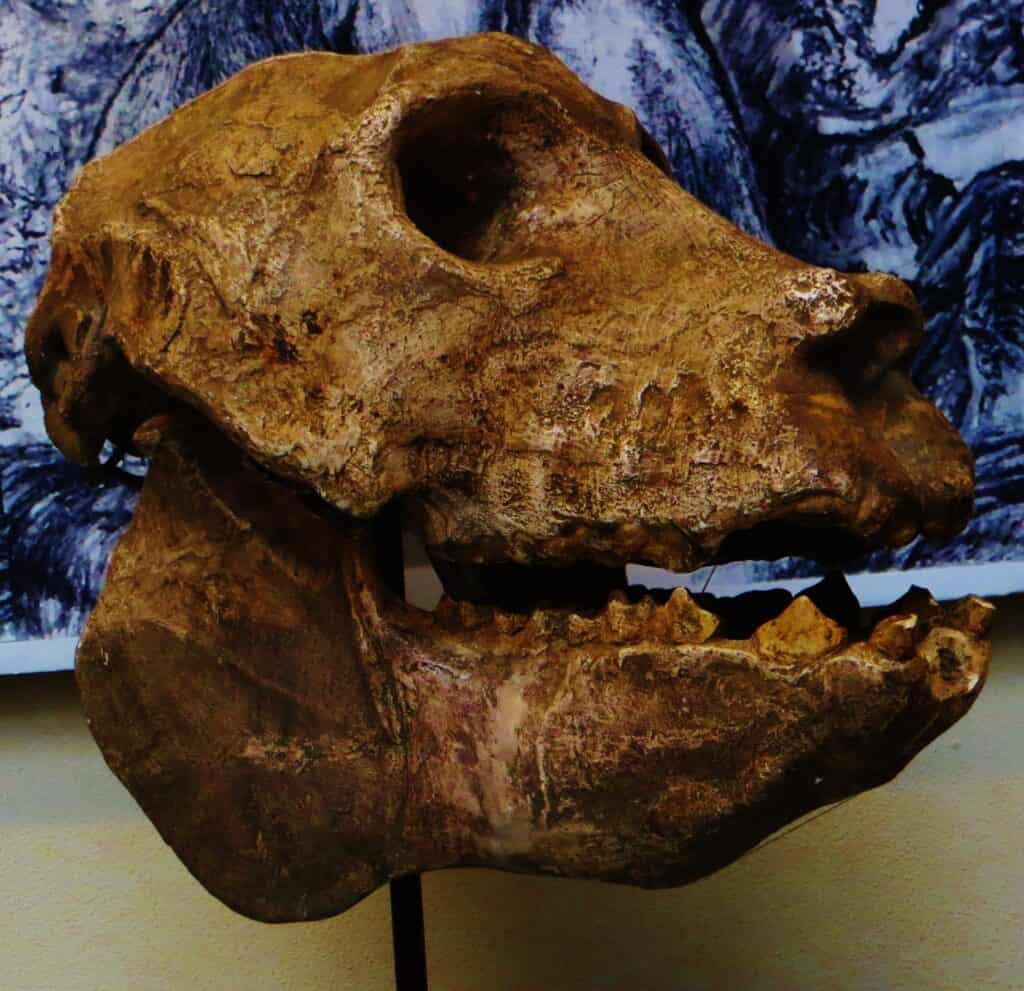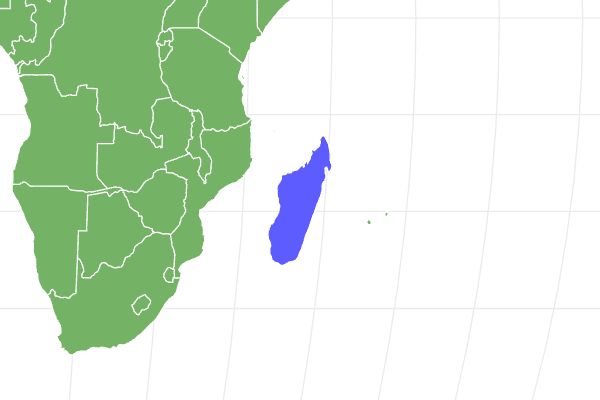Archaeoindris
Archaeoindris Fontoynontii
Archaeoindris was the largest primate to evolve in Madagascar
Advertisement
Archaeoindris Scientific Classification
- Kingdom
- Animalia
- Phylum
- Chordata
- Class
- Mammalia
- Order
- Primates
- Family
- Palaeopropithecidae
- Genus
- Archaeoindris
- Scientific Name
- Archaeoindris Fontoynontii
Read our Complete Guide to Classification of Animals.
Archaeoindris Conservation Status
Archaeoindris Facts
View all of the Archaeoindris images!
Archaeoindris is an extinct genus of giant lemurs that lived in Madagascar till about 350 BCE. The only known member of this genus is the Archaeoindris fontoynontii. This ancient lemur was similar in size to present-day gorillas and is the largest primate to have evolved on Madagascar. It belonged to a family of lemurs known as Palaeopropithecidae or sloth lemur. It is often considered similar to the ground sloths that once lived on the continents of North and South America due to its large size.

Archaeoindris is an extinct creature that resembled a giant lemur. These ancient animals lived in Madagascar.
© – License
Description & Size
Archaeoindris is a genus of giant lemurs that is now extinct. Similar in size to an adult male gorilla, this giant sloth lemur was the largest primate to have ever evolved on Madagascar. Archaeoindris belongs to a family of lemurs known as sloth lemurs (Palaeopropithecidae). Despite their common name, it is important to note that sloth lemurs are not actual sloths and are not related to them. However, given their large size, people often compare this primate to the ground sloth.
The closest relative of the Archaeoindris is the Palaeopropithecus. This is the second largest type of sloth lemur. Some of their living relatives include the Indri, wooly lemurs, and sifakas. The generic name, Archaeoindris, means “ancient indri-like lemur,” which is interesting since this creature only became extinct recently (around 350 BCE)
It has been challenging to determine the size of Archaeoindris due to incomplete skeletal remains. As a result, the available size estimates vary widely based on the limited remains discovered so far. Some estimates claim that this sloth lemur was as big as 244 kilograms (538 pounds). However, more conservative estimates put the mass at about 160 kg (350 lb). Regardless of the size estimates you use, scientists believe the Archaeoindris was one of the largest primates to have ever walked the planet.
Most of the Archaeoindris bones found so far are cranial bones. From available fossil records, the Archaeoindris was a massive and robust primate with many traits similar to that of the Palaeopropithecus. The arms of this sloth lemur were longer than its legs. However, no foot or hand bones have been found to get a clear picture of how it really looked.
Diet – What Did Archaeoindris Eat?
Scientists think the Archaeoindris was an herbivorous animal. Studies that examined the wear patterns of its teeth and other features suggest that it ate mainly leaves (folivorous). However, it might have had a varied diet that includes seeds and fruits.
Habitat – When and Where Archaeoindris Lived
The Archaeoindris was discovered in the Ampasambazimba fossil site in Central Madagascar. The formation where it was found dates back to the Late Quaternary period. Although the area where the fossil was found is currently a grassland habitat, it was more of an open habitat when the Archaeoindris was around. The site was a mix of bushlands, woodlands, and savannah.
There are different theories about how this animal lived. The prevailing thought is that it was a slow-moving tree dweller. The morphology of the Archaeoindris’ hip joint suggests that it lived a predominantly arboreal life. However, some experts think it spent time on the ground as well.
Like other giant lemurs, the Archaeoindris was a diurnal animal. The relatively small orbit of this giant lemur suggests that it was more active during the day than at night, like present-day gorillas.
Threats and Predators
Scientists believe that the Archaeoindris was still alive in Madagascar when humans arrived on the west coast of the high plateau. Their arrival would have been the biggest threat to the existence of the Archaeoindris. Humans would have hunted it for food, and their activities would have destroyed its habitat.
Discoveries and Fossils – Where It was Found
Herbert F. Standing described the first fossil in 1909. The initial description was based on fragmentary jaw bones. However, a relatively complete skull bone was discovered later. Most of the fossils of the Archaeoindris that have been found so far are cranial bones. Only six bones from the lower skeletons have been found so far. The only site where this primate has been excavated so far is Ampasambazimba, a subfossil site in central Madagascar. After its initial discovery, some fossils that belonged to the Megaladapis grandidier were wrongly attributed to the Archaeoindris. However, this has since been corrected.
Extinction – When Did It Die Out?
Once a successful species-rich family, all the members of the sloth-lemur family, including the Archaeoindris, are now extinct. This big primate lived till about 350 BCE, when humans arrived in Madagascar. Hunting and habitat loss are the major factors contributing to the genus’s disappearance.
Similar Animals to The Archaeoindris
Similar animals to this animal include:
- Palaeopropithecus – This is a genus of large sloth lemurs that lived in Madagascar until they became extinct recently.
- Mesopropithecus – A genus of small to medium-sized lemurs. It is a member of the sloth-lemur family along with Palaeopropithecus.
- Babakotia – this is an extinct genus of medium-sized lemur. Like other members of its family, it lived in Madagascar.
Related Animals
View all 194 animals that start with AArchaeoindris FAQs (Frequently Asked Questions)
When was Archaeoindris alive?
The Archaeoindris lived till about 350 BCE. This is interesting considering the fact that the name of the genus translates as “ancient indri-like lemur.” The arrival of humans in Madagascar most likely contributed to the disappearance of the already struggling population of sloth lemurs.
How big was Archaeoindris?
The Archaeoindris is often compared to a gorilla. Size estimates for this sloth lemur vary considerably because only cranial fossils have been discovered so far. According to some estimates, it was about 244 kilograms (538 pounds) in weight. However, more conservative estimates put the weight at about 160 kg (350 lb).
What are the closest living relatives of the Archaeoindris?
Despite the size comparison and name similarities, the Archaeoindris is unrelated to sloths. Living relatives of this sloth-lemur include the indri, sifakas, and woolly lemurs.
Thank you for reading! Have some feedback for us? Contact the AZ Animals editorial team.
Sources
- Prehistoric-Wildlife.com, Available here: http://www.prehistoric-wildlife.com/species/a/archaeoindris.html
- Wikipedia, Available here: https://en.wikipedia.org/wiki/Palaeopropithecus
- Wikipedia, Available here: https://en.wikipedia.org/wiki/Archaeoindris
- Roman Uchytel, Available here: https://prehistoric-fauna.com/Archaeoindris-fontoynonti
- Dbpedia, Available here: https://dbpedia.org/page/Archaeoindris
















